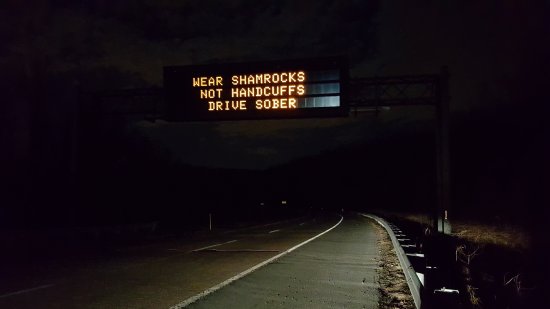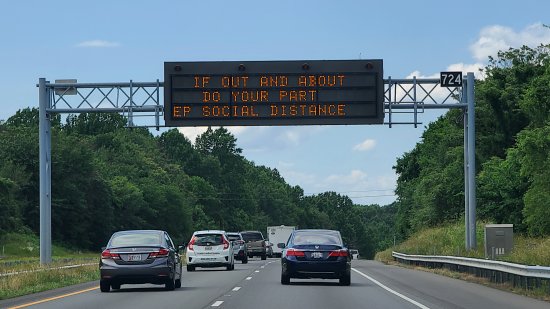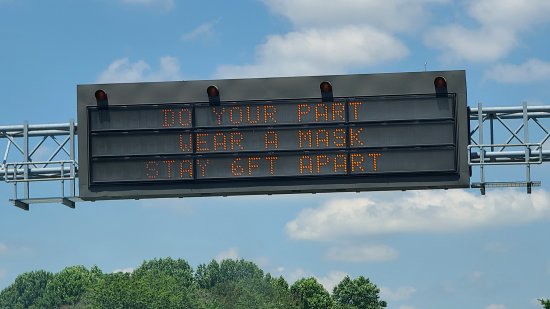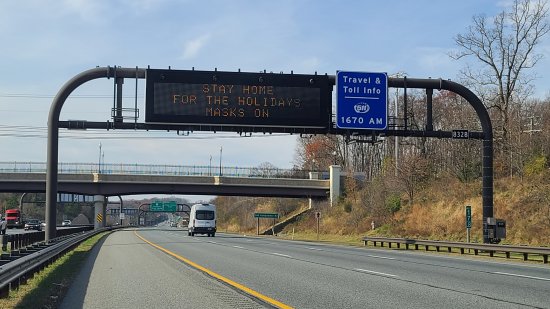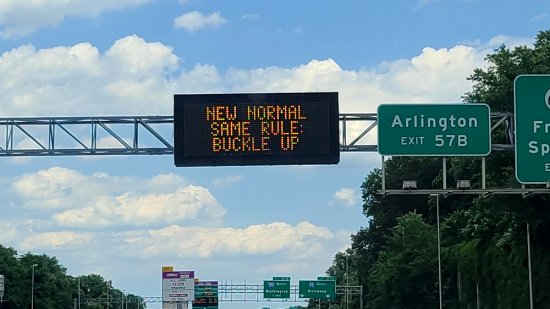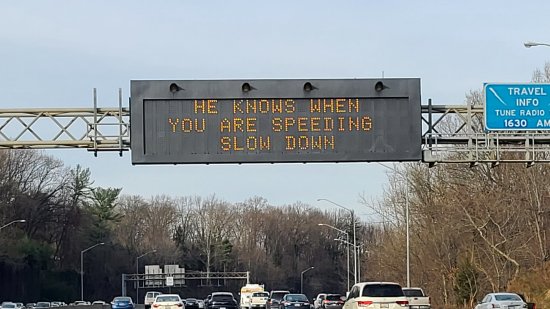No more cutesy safety messages?
6 minute read
January 7, 2021, 5:18 PM
On January 4, 2021, the Federal Highway Administration (FHWA) issued a ruling providing “an official interpretation of the provisions of the 2009 edition of the Manual on Uniform Traffic Control Devices for Streets and Highways (MUTCD) related to changeable message sign messaging”. In a nutshell, this ruling bans all of those cutesy safety messages that highway departments love putting on those overhead message signs, such as this one:
This particular one is from March 17, 2016 on US 29 in Maryland, and promotes responsible use of adult beverages, i.e. don’t drive drunk. I’m sure that you can think of other messages that you’ve seen that are similar, related to drunk driving and seat belt usage. I never minded these messages, because ultimately, they were PSAs about safety while driving. As long as it was travel-related and not preempting a more urgent message, fine. Especially because, for whatever reason, despite decades of anti-drunk driving campaigns and mandatory seat belt laws, people still do these things. The seat belt part especially surprises me, because I still read far too often about someone’s being ejected from their car during an accident because they weren’t wearing a seat belt, which would have prevented that. I lack sympathy for those people, because the first thing that comes to my mind when I read about such things is that the idiot wasn’t wearing their seat belt, which would have kept them in their seat, where they belonged. After all, we want to keep such driver’s ed films as Alice’s Adventures Through the Windshield Glass and The Decapitation of Larry Leadfoot in the realm of fiction, and not play them out in real life.
However, in the last year, I’ve seen these message signs used for a different purpose: pandemic-related propaganda. Maryland in particular, it seems, has loved to run messages about masks and social distancing and such. Here are some examples that I’ve spotted:
This is not limited to Maryland, of course. On a recent trip up north to see family, Delaware had a message on the overhead on I-95 that said, “A simple ask. Wear a mask”. I was quick to respond with, “Get a clue. Fuck you.”
Virginia jumped on the bandwagon as well, but in that case, they tried to keep it at least somewhat road-related, mixing pandemic and road safety:
In any case, this propagandizing has become so prevalent that the return of the usual cutesy safety messages’ for Christmas was noteworthy enough to warrant a photo:
What does it say when normal becomes noteworthy? But in any case, all of the above-named examples are now banned. And in their ruling, the FHWA makes the perfect case for these. It all boils down to this fundamental principle:
Traffic control devices or their supports shall not bear any advertising message or any other message that is not related to traffic control.
Last I checked, messages about seat belt usage, drunk driving, and especially pandemic-related propaganda, are not related to traffic control. They also fail some other principles of an effective traffic control device:
Convey a clear, simple meaning. Clear and simple messages are easy to read and comprehend with only short glances away from the roadway, resulting in minimal visual and cognitive distraction from the driving task. The use of witticisms, colloquialisms, and popular culture references that target or are comprehended only by a limited segment of the population is not consistent with a clear, simple meaning for all. Instead, these messages rely on hidden meanings or targeted cultural knowledge to understand the message. Similarly, the use of newly coined terms (neologisms), words combining the meanings of two words or blending of sounds (portmanteaus), metadata tags (“hashtags”), electronic shorthand (“Internet slang”), and other forms that do not use conventional syntax do not convey a clear, simple meaning to many road users.
Command respect from road users. Respect for CMS is gained through the posting of information that is relevant to all road users at the location and time it is displayed. Just as important, CMS messages also command respect through the consistent use of simple, official language and design. The use of colloquialisms, popular culture references, and other types of indirect or potentially esoteric messaging tends to diminish respect of a CMS as a traffic control device because of its unauthoritative tone and its similarity to promotional advertising that employs a similar approach.
The cutesy road safety messages tend to fail the principle of “convey a clear, simple meaning” by assuming that people understand certain cultural elements. In the case of the St. Patrick’s Day one, it assumes that someone is familiar with St. Patrick’s Day and knows what a shamrock is. Imagine that someone had never heard of it, such as a recent immigrant from an area where St. Patrick’s Day was not celebrated. Now you’ve got someone going down the road thinking, “What is a shamrock, and why do I need to wear one?” That thought is now taking at least some of their attention away from safely moving their vehicle down the road. In the case of the Christmas-related one, if someone has never heard of the “Santa Claus Is Comin’ to Town” song, the message doesn’t make sense anymore, and the meaning is lost, and you again have a confused driver who is thinking about the message, taking a little bit of brain power away from the task of driving. We don’t want that, because a distracted driver is a dangerous driver. Don’t forget that distracted driving comes in many forms, and doesn’t just mean a driver with a phone in their hand.
The pandemic-related propaganda, meanwhile, has zero to do with traffic control. It also fails to command respect from road users. I know it fails this, because I look at it and it causes me to lose respect for a whole host of entities because these signs that are supposed to be for road-related messaging are now being used for blatant propaganda about social distancing, lockdowns, and mask-wearing. My response to the Delaware message is a perfect example of this, as I was clearly not having it. Don’t waste my time with a non-road-related message when I’m trying to drive. I have my own opinions about the official response to the pandemic, and it’s generally not complimentary, but this is not the time for that discussion.
Additionally, keeping these signs lit all the time causes their messages to blend into the background. The FHWA even said as much:
It is important that any safety campaign related messages be limited in duration. Displaying safety campaign messages on a near‑continuous basis can be counterproductive to the intended purpose, as motorists might habituate to and ignore messages that are displayed for long periods of time or with such frequency or predictability that motorists perceive them as being displayed continually.
With their continual use for propaganda, seeing a message on there is nothing new. It’s just like any other sign that you see every day while out on the road. You know it’s there, you’re used to it, and therefore you don’t even really see it anymore. So when a message that is actually pertinent comes through, you might miss it because you’re used to seeing it lit up with all of the garbage messages. If the sign is normally dark, and only lit up for pressing matters, then it’s going to get your attention. You’re going to notice it because it’s something different, you’re going to read it, and then respond accordingly.
All in all, when properly used, these devices are wonderful things, as they are able to convey pertinent information regarding traffic conditions for drivers in order to help keep traffic moving smoothly, such as one time when a sign alerted me to an accident on I-95 while I was traveling to Richmond. In that case, I was able to get off the freeway in plenty of time, take Route 1 around the accident, and then get back on 95 after I was past the accident. It saved me time when I was trying to get somewhere by alerting me to a problem on my route. But when it’s used for other things that are not directly related to my ability to get where I’m going, it cheapens the system, causes more clutter on the roads, and makes it less likely that actual pertinent messages will have the impact that they need to have. And for that, I’m glad that all of the cutesy safety messages and unrelated propaganda are now banned.
Categories: Roads










